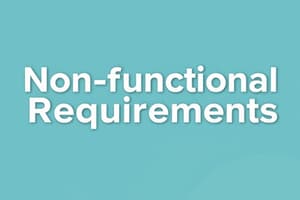Podcast
Questions and Answers
What is the primary goal of requirements management?
What is the primary goal of requirements management?
- To establish the software requirements document
- To eliminate all non-functional requirements
- To define financial constraints for the project
- To manage changing requirements throughout the development process (correct)
Which of the following best describes functional requirements?
Which of the following best describes functional requirements?
- They specify the services that the system must provide. (correct)
- They outline the project budget and timelines.
- They describe how the system should maintain security.
- They are constraints on the system's development process.
What is a key characteristic of non-functional requirements?
What is a key characteristic of non-functional requirements?
- They represent detailed user interactions with the system.
- They often impose constraints on system performance or usability. (correct)
- They define specific computations the system must perform.
- They are easier to document than functional requirements.
What should a software requirements document accomplish?
What should a software requirements document accomplish?
Which of the following processes is part of the requirements engineering process?
Which of the following processes is part of the requirements engineering process?
Which technique is commonly used for requirements elicitation?
Which technique is commonly used for requirements elicitation?
Why is it important to maintain links between dependent requirements?
Why is it important to maintain links between dependent requirements?
What role does iterative development play in requirements engineering?
What role does iterative development play in requirements engineering?
What is a potential outcome of not having a formal process for change proposals in requirements management?
What is a potential outcome of not having a formal process for change proposals in requirements management?
In which scenario would requirements negotiation be necessary?
In which scenario would requirements negotiation be necessary?
Flashcards are hidden until you start studying
Study Notes
Requirements Overview
- Requirements pertain to overall system performance rather than individual features or services.
- Domain requirements impose constraints based on the operational context of the system.
Functional Requirements
- Define specific functionalities or services the system must deliver.
- Vary by software type, expected users, and the system's environment.
- High-level functional user requirements outline what the system should achieve.
- Detailed functional system requirements specify how services operate.
Non-Functional Requirements
- Focus on quality attributes and system constraints, not strictly on functionality.
- Highlight how a function is performed rather than what the function entails.
- Process requirements may dictate specific tools, languages, or methods for development.
- Often more critical than functional requirements, as unmet non-functional needs can render a system ineffective.
Non-Functional Classifications
- Product requirements dictate the product's performance characteristics (e.g., speed, reliability).
- Organisational requirements arise from company policies, such as process standards and implementation details.
- Conflicting requirements may arise from differing stakeholder perspectives influenced by organisational dynamics.
- Requirements evolve throughout the analysis, with new stakeholders and changing business needs.
Requirements Elicitation and Analysis
- Involves engaging stakeholders to gather insights about application domain and necessary system services.
- Key stages consist of:
- Requirements discovery: Engaging with stakeholders to identify needs.
- Classification and organization: Grouping and structuring related requirements.
- Prioritization and negotiation: Resolving conflicts and determining importance.
- Specification: Documenting requirements for subsequent project phases.
Challenges in Requirements Elicitation
- Stakeholders may struggle to articulate precise wants.
- Different expressions of requirements lead to potential misunderstandings.
- Conflicts may exist between various stakeholder requests.
- Changes to requirements can occur as analyses progress, influenced by new inputs or environment shifts.
Software Requirements Document
- Serves as the formal statement detailing what developers need to deliver.
- Includes both user and system requirements, clarifying expectations without dictating design elements.
- Should comprehensively define what the system is expected to accomplish.
Requirements Specification Process
- Involves documenting user and system requirements for clarity and contractual purposes.
- User requirements must be accessible to non-technical end-users.
- System requirements tend to be more technical and detailed.
Methods for Writing System Requirements
- Natural language: Simple, numbered sentences capturing each requirement.
- Structured natural language: Standard templated forms for consistency.
- Graphical notations: Diagrams (like UML use case and sequence diagrams) complemented by text.
- Mathematical specifications: Uses formal mathematical concepts for clarity but may be misunderstood by non-technical stakeholders.
Requirements Validation
- Ensures that requirements align with customer expectations.
- High cost of fixing post-delivery errors emphasizes the necessity of thorough validation.
Requirements Checking Criteria
- Validity: Assessing whether the system meets customer needs.
- Consistency: Identifying and resolving conflicting requirements.
- Completeness: Ensuring all necessary functions are captured.
- Realism: Evaluating feasibility given available resources and technology.
- Verifiability: Establishing if requirements can be effectively checked.
Techniques for Requirements Validation
- Reviews: Conducting detailed assessments of documented requirements.
- Prototyping: Creating executable models to verify requirements.
- Test-case generation: Producing tests to check requirement fulfillment.
Requirements Management
- Essential to manage changing requirements throughout the development lifecycle.
- Keeping track of requirements and their interdependencies is vital for assessing impacts from changes.
- Establishing formal procedures for change proposals helps maintain coherence throughout development.
Key Points Summary
- Software system requirements define operational constraints and service expectations.
- Functional requirements articulate necessary system services, while non-functional requirements shape system development.
- The software requirements document serves as a mutual agreement between stakeholders and developers.
- Requirements engineering is an iterative process encompassing elicitation, specification, and validation.
- Various techniques, such as interviews, scenarios, use-cases, and ethnography, aid in the requirements gathering phase.
Studying That Suits You
Use AI to generate personalized quizzes and flashcards to suit your learning preferences.




